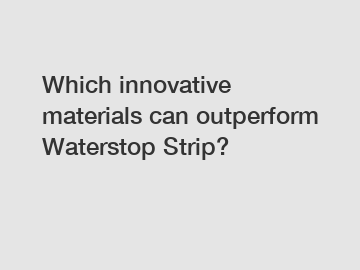Which innovative materials can outperform Waterstop Strip?
Which innovative materials can outperform Waterstop Strip? This question lingers in the minds of construction professionals and engineers seeking more efficient and sustainable alternatives. In recent years, researchers have explored various materials that exhibit superior performance, durability, and environmental advantages over traditional waterstop strips.
One innovative material worthy of attention is hydrogel. This novel material possesses remarkable water-absorbing capacity and swelling behavior, which allows it to seal concrete joints effectively. Hydrogels are composed of a three-dimensional network of hydrophilic polymer chains, enabling them to absorb large amounts of water and expand. This unique property ensures a robust and durable seal, effectively preventing the leakage of water and harmful substances. Additionally, hydrogels are highly flexible and adaptable, able to accommodate joint movements caused by thermal expansion and contraction.
The adaptability and versatility of hydrogels make them ideal for a wide range of applications. They can be utilized in various construction joints such as expansion joints, cold joints, and control joints. By replacing conventional waterstop strips with hydrogels, construction projects can enjoy enhanced durability and leak-proofing capabilities. Moreover, hydrogels are compatible with various construction materials, including concrete, steel, and PVC. This compatibility facilitates their integration into existing structures without the need for major modifications or extensive construction works.

Another material showing promise in outperforming waterstop strips is self-healing concrete. This innovative material possesses the ability to repair and regenerate cracks autonomously, thereby ensuring the long-term integrity and durability of concrete structures. Self-healing concrete incorporates capsules filled with healing agents, such as bacteria or superabsorbent polymers. When cracks form, these capsules rupture, releasing the healing agents to react and heal the damaged areas.
The utilization of self-healing concrete offers significant advantages in terms of sustainability and cost-effectiveness. Repairing and maintaining concrete structures often entail costly and time-consuming efforts. By implementing self-healing concrete, the need for frequent repairs and interventions can be reduced, resulting in substantial cost savings and minimizing disruptions to construction projects. Furthermore, the extended lifespan of structures built with self-healing concrete contributes to the overall sustainability of the built environment, reducing material consumption and waste generation.
In conclusion, innovative materials such as hydrogels and self-healing concrete offer promising alternatives to traditional waterstop strips. These materials possess exceptional properties that ensure effective sealing, adaptability to joint movements, and autonomous self-repair. By adopting these innovative materials, construction professionals and engineers can enhance the durability, sustainability, and efficiency of their projects. The continuous exploration and adoption of such materials will undoubtedly contribute to the advancement and evolution of the construction industry.
Contact us to discuss your requirements of Aoyuan Rubber Machine Belt, Aoyuan Rubber Machine Belt, Aoyuan Rubber Machine Belt. Our experienced sales team can help you identify the options that best suit your needs.

Comments